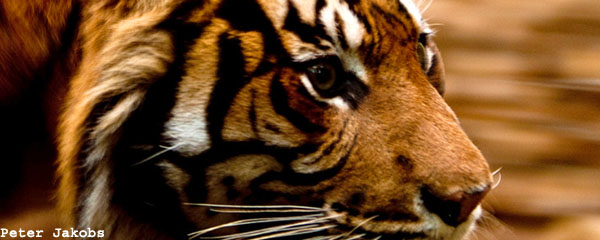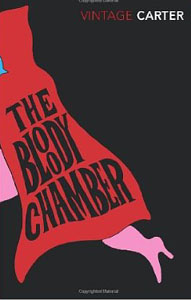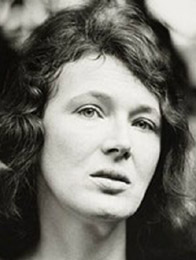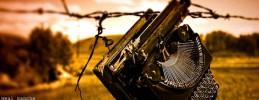
photo by Peter Jakobs
Angela Carter’s Beauties and Beasts:
‘The Courtship of Mr Lyon’ and ‘The Tiger’s Bride’
by Chrissy Derbyshire
The Bloody Chamber is a deceptively slim volume, for this strange beast of a book is easily as baroque as any of Carter’s writings. Yet, while it is unmistakably hers, it has about it an atmosphere quite unlike anything in her oeuvre. It comes from the half-remembered Black Forest of childhood enchantments and fears, seen through the lens of adulthood. Or, more specifically, of adult desire. Salman Rushdie, in his introduction to Carter’s collected short stories, calls it her ‘masterwork’.
If one motif can be said to dominate the world of The Bloody Chamber, it is that of the beauty and the beast. Consistently, loveliness is paired with wildness, violence, cruelty. The young bride of the ‘The Bloody Chamber’ finds herself enacting the story of ‘Bluebeard’ in a Sadean castle by the sea. Snow White (‘The Snow Child’) falls into the world at the whim of a Count, only to be killed by his wife, before falling prey to his necrophiliac desire and melting into a spot of blood on the snow.
 Fresh snow fell on snow already fallen; when it ceased, the whole world was white. ‘I wish I had a girl as white as snow,’ says the Count. They ride on. They come to a hole in the snow; this hole is filled with blood. He says: ‘I wish I had a girl as red as blood.’ So they ride on again; here is a raven, perched on a bare bough. ‘I wish I had a girl as black as that bird’s feather.’ As soon as he completed her description, there she stood, beside the road, white skin, red mouth, black hair and stark naked.
Fresh snow fell on snow already fallen; when it ceased, the whole world was white. ‘I wish I had a girl as white as snow,’ says the Count. They ride on. They come to a hole in the snow; this hole is filled with blood. He says: ‘I wish I had a girl as red as blood.’ So they ride on again; here is a raven, perched on a bare bough. ‘I wish I had a girl as black as that bird’s feather.’ As soon as he completed her description, there she stood, beside the road, white skin, red mouth, black hair and stark naked.
Beauties and wolves come together in myriad ways, tender bedfellows in the three wolf stories that inspired Neil Jordan’s film The Company of Wolves. But two tales stand apart as direct descendants from the tale we know as ‘Beauty and the Beast’. Coming one after another towards the beginning of the book, ‘The Courtship of Mr Lyon’ and ‘The Tiger’s Bride’ act almost as a statement of intent. They are delicious, moving and thought-provoking pieces.
The most commonly told and retold version of ‘Beauty and the Beast’ is Madame de Beaumont’s ‘La belle et la bête’, a well-mannered and moralistic tale of novelette length, written in 1757. In the Afterword to her first collection, Fireworks, Angela Carter noted she is long an admirer of ‘gothic tales, cruel tales, tales of terror’, and was frustrated by the damping down of folktales into ‘parables of instruction’. Her own ‘Beauty and the Beast’ stories provide interesting subversions of the patronising nursery tale that urges little girls to value good character above appearances, while presenting a protagonist who is, by definition, the embodiment of physical beauty. ‘The Courtship of Mr Lyon’ is the more instantly recognisable of the two, ostensibly never straying far from the known and accepted versions of ‘Beauty and the Beast’.
‘My good fellow–’ stammered Beauty’s father; but the only response was a renewed roar.
‘Good fellow? I am no good fellow! I am the Beast, and you must call me Beast, while I call you, Thief!’
‘Forgive me for robbing your garden, Beast!’
Head of a lion; mane and mighty paws of a lion; he reared on his hind legs like an angry lion yet wore a smoking jacket of dull red brocade and was the owner of that lovely house and the low hills that cupped it.
‘It was for my daughter,’ said Beauty’s father. ‘All she wanted, in the whole world, was one white, perfect rose.’
Carter, however, was keen to distance herself from suggestions that, in The Bloody Chamber, she had merely dashed off a series of fairytales in her own words. “My intention,” she said in one interview, “was not to do ‘versions’ or, as the American edition of the book said, horribly ‘adult’ fairy tales, but to extract the latent content from the traditional stories and to use it as the beginnings of new stories.”
‘The Courtship of Mr Lyon’, then, is a story of ideas. This story’s Beauty is constantly called out on her strange preoccupation with goodness and duty. Though she gets her fairytale ending – beast into man, long walks in the garden with her prince while the family dog snoozes on – the reader is acutely aware of the unnecessary self-sacrifice which has, seemingly arbitrarily, led to this point. What, really, does a young girl owe to a semi-refined gentleman lion who would take a prisoner in exchange for a rose? Or to the father whose conscience is apparently untroubled by his daughter’s predicament? The nature of the traditional ‘good girl’ is brought into stark relief against this folkloric backdrop. She casts herself as a sacrificial lamb, and is rewarded. So soon after the carnage of the opening story, ‘The Bloody Chamber’ itself, we shiver at the danger of such a gamble from this beauty.
There seemed a heavy, soundless pressure upon her in his house, as if it lay under water, and when she saw the great paws lying on the arm of his chair, she thought: they are the death of any tender herbivore. And such a one she felt herself to be, Miss Lamb, spotless, sacrificial.
Yet she stayed, and smiled, because her father wanted her to do so…
 ‘The Tiger’s Bride’ is something else altogether – stranger, darker, more overtly touched by sexuality, and with a protagonist driven by pride and honour rather than a good girl’s taste for martyrdom. Here, the opening sentence, ‘My father lost me to The Beast at cards’, introduces at once the heroine’s worldly cynicism. The Beast would see her naked, nothing more, and she uses his desire for her nakedness as an ace. Never, even in the vulnerability of her nudity, is she debased. Her worldliness earns her a wilder and stranger happy ending than that of ‘The Courtship of Mr Lyon’. The Beast licks the skin off her with his sandpaper tongue, revealing beneath her human façade a feral thing like himself. ‘My earrings turned back into water and trickled down my shoulders,’ she writes. ‘I shrugged the drops off my beautiful fur.’
‘The Tiger’s Bride’ is something else altogether – stranger, darker, more overtly touched by sexuality, and with a protagonist driven by pride and honour rather than a good girl’s taste for martyrdom. Here, the opening sentence, ‘My father lost me to The Beast at cards’, introduces at once the heroine’s worldly cynicism. The Beast would see her naked, nothing more, and she uses his desire for her nakedness as an ace. Never, even in the vulnerability of her nudity, is she debased. Her worldliness earns her a wilder and stranger happy ending than that of ‘The Courtship of Mr Lyon’. The Beast licks the skin off her with his sandpaper tongue, revealing beneath her human façade a feral thing like himself. ‘My earrings turned back into water and trickled down my shoulders,’ she writes. ‘I shrugged the drops off my beautiful fur.’
Angela Carter’s ‘Beauty and the Beast’ stories could stand as a microcosm of The Bloody Chamber as a whole. They are vignettes of male-female relations, and particularly of the woman’s role and identity within those relations. They are also dark fairytales in their own right, familiar yet surprising and even, at times, shocking. They are by turns erotic, repugnant, melancholy, but also blackly funny. In Helen Simpson’s introduction to this collection, Carter is quoted: “The short story is not minimalist, it is rococo. I feel in absolute control.” And in reading these stories, it is hard to doubt her. This is, indeed, the work of a writer in absolute control. Carter manipulates a fantastic, richly allusive and sensual world with the light touch of a master magician. These are stories in which to lose yourself, find yourself and change your ways.


One thought on “Angela Carter’s Beauties and Beasts”
Comments are closed.